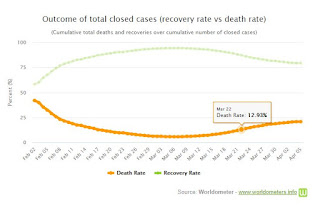The real underlying issue is what is a pandemic? History provides some clue to this answer. Start with what is considered the 5-6 Worst Pandemics in History .
(1) The Bubonic Plague/Black Death 1347- 1351 75-200 million deaths worldwide
(2) Spanish Flu (H1N1) - 1918-1919 50 million worldwide deaths (675,000 USA)
(3) Asian Flu (H2N2) - 1957 1.1 million worldwide deaths (116,000 USA)
(4) Hong Kong Flu (H3N2) - 1968 1 million worldwide deaths (100,000 USA)
(5) Swine Flu (H1N1) - 2009-2010 575,400 worldwide deaths (12,469 USA)
(6) HIV/AIDS - 1980 - 2006 25 million deaths worldwide (still in process)
The Worldometer Coronavirus daily count is now at 233,686 worldwide deaths and 63,765 in USA so by the numbers it may surpass the #4 and #3 in absolute numbers.
But the absolute numbers are still flawed in revealing a solution. For example: The Spanish Flu, which lasted 36 months, in it's first wave (Jan 1918 - October 1918) killed 200,000 people in the USA (about 0.194% of the 103 million population). The estimated infected population was 1/3 so the actual mortality rate for the first wave was about 0.582%. Presented in a percentage that number seems no different from the seasonal flu. This numbers nonsense is used to criticize the shelter-in-place actions (either soft or hard).
A recent RedState article was sent to me "If Wuhan Virus Is SoBad, Why Are Deaths So Low?" that attempted to justify why "There is really no medical reason to pursue this nonsense." The data looks legitimate sourcing from the CDC, yet a quick check on the actual site of Vital Statistics shows quite a different picture.
 |
| https://www.cdc.gov/nchs/nvss/vsrr/COVID19/ |
It just shows that normal - is in whatever numbers make you feel normal. And that's the definition of nonsense - predicting deaths that we call "normal levels".












